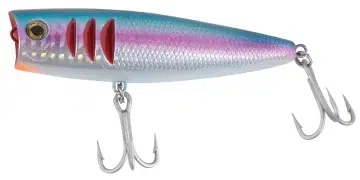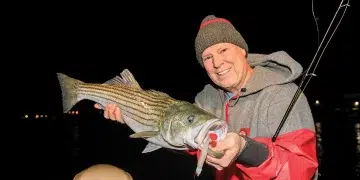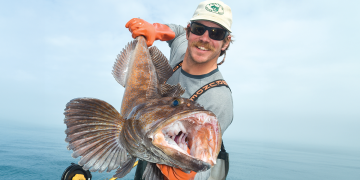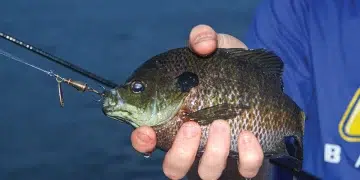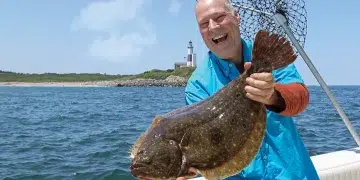How to Catch Giant Bluefin Tuna: Fishing Tips for Success

From New Jersey through Massachusetts, giant bluefin tuna are closer than you think.
You can sense the bite is coming any second. For 15 minutes, you’ve been drifting among breaking pods, fishing for giant bluefin tuna—some measuring more than 100 inches long and weighing several hundred pounds. Suddenly, just 60 feet off your port stern, the surface erupts with a series of Volkswagen-sized swirls pushing a tightly packed school of adult bunker straight toward your free-lined offering of the same. It takes only a couple seconds before the reel’s clicker sounds the strike. You’re into a big bluefin, the first giant you’ve hooked on your own—and you’re less than 10 miles from the inlet!
What Northeast angler hasn’t dreamed of that first giant tuna encounter? Whether you’ve envisioned it as worthy of a Hemmingway introduction or an outtake from the Wicked Tuna television series, nothing can fully prepare you for that first runoff and all that power at the end of the line.
“Initial encounters can be absolutely wild,” says Capt. John McMurray of One More Cast Light Tackle Charters out of Oceanside, New York (nyctuna.com). “Sometimes, big fish swallow your bait and play opossum for a few seconds before taking off. Once that fish gets moving, though, you’ll be amazed how quickly it can power away. Your heart will be pumping, the crew will be shouting, and the adrenalin shot will be amazing for the first few minutes—and then the work begins. It’s thrilling that you can find these fish now as close as thirty minutes from our dock.”
While many anglers might guess a run of 30, 40, or even 50 miles offshore is needed to tangle with giant tuna, these big bluefins—some topping 900 pounds—have been running closer to the beach in recent years than you might suspect. “I think it’s a combination of abundant bait and good pelagic management over the past few years that is really having a positive effect on the bluefin population,” says Bryce Poyer, proprietor of White Water Outfitters in Hampton Bays, New York (whitewateroutfitters.com). His shop has a reputation as one of the top tuna outfitters in the Northeast, with a full lineup of inshore and offshore gear, plus custom rods designed to battle everything from bay-fishing favorites to the biggest and baddest bluefins on the planet.
“There have long been bluefin in our nearshore waters, but the influx of massive bunker schools has really drawn these fish up tight to the beach in good numbers,” explains Poyer. “Now, you can have reasonable expectations of encountering them anywhere from the surf line to twenty miles out. We regularly have customers connecting with these beasts twenty to thirty minutes beyond the breakers of Shinnecock and Moriches inlets in sixty- to one hundred-foot depths. You can easily reach them in a twenty-three-foot center console if you choose your days carefully.”

Poyer notes small bluefin weighing less than 60 pounds generally don’t care to predate on adult bunker, or that far inshore. But the giants like big baits and aren’t afraid of cruising shallow, and don’t seem to need the crystal-clear blue water that triggers smaller bluefin to feed.”
Capt. Robbie Taylor of Newport Sport Fishing Charters in Newport, Rhode Island, has seen the same along the Rhody and Bay State coasts (nsfcharters.com). “We’ve got schools of menhaden here, too, plus massive piles of sand eels; two baits big tuna really like. We start seeing giants off Block Island in July, and they stay through the fall and into December,” he reveals. “That puts them an hour or less out of Newport. I love a ninety-foot contour, so that’s where I like to look first, but anywhere between fifteen and twenty fathoms puts you in the ballpark.”
Down off the New Jersey coast, giants are a thing now too. “We’re seeing big fish seven to twenty miles off the beach these days,” says Capt. Dave DeGennaro of the Barnegat, New Jersey, charter vessel Hi Flier (hiflier.com/the-boat). “For us, the bunker is a draw, but we’ve also had a ton of big squid in recent years, and chub mackerel too. The exact hot spots vary from year-to-year based on where the bait lands, but once that fishing sets up, it’s consistent through the fall. We have no problem reaching those fish in our twenty-five-foot World Cat catamaran.”
Subscribe Here For Weekly Updates
While the temptation to fire up your engines and head off in search of a bluefin beast might be tough to temper, be aware this isn’t a sport for novice anglers or those lacking big tuna experience. Thus, the smart move is to hop on a charter boat or take a couple trips with an experienced friend for an up close and personal introduction before trying this on your own.
Of course, when you eventually do head out with your own crew, you’ll need some specialized gear, heavy tackle, and a well-thought-out game plan for battling your quarry. Since few recreational anglers purchase the federal permits required to take giant tuna, you’ll also need to figure out how to refresh your fish for a live release after getting it to the gunwale. “Seeing all this done in person saves a lot of headaches,” advises Taylor, who last year alone decked three New England bluefins that topped the 900-pound mark.
In terms of giant tuna tackle, discussion with a local tackle shop that specializes in offshore fishing is the logical starting place. There is some flexibility in choices as long as you opt for high-quality selections. DeGennaro, for example, loves his 130-class stand-up rods made by E-Fishent Custom Rods (efishentcustomrods.com). “I match those to eighty-class Avid reels and use a one hundred and fifty-pound-test fluorocarbon top shot leader with two hundred-pound-test braid running line,” he says. “A live bunker or chub mackerel on a nine-zero circle hook is my usual bait.”
Taylor, by comparison, heads out with 135-class tackle, 30 feet of 180-pound-test fluorocarbon leader material, a size 12/0 circle hook, and 500-pound-test Jerry Brown main line to help prevent breakoffs around the numerous lobster pots in the areas he likes to prospect. For bait, he favors bunker (aka pogie or menhaden) but will live-line big squid if the eight-armed mollusks infest the area. “You’ll also want to invest in a barbless swim hook with a trip rope to release your trophy,” adds Taylor. “Tow that fish around at about two knots until it gets color back before letting it go to battle another day.”
Poyer notes some bluefin fans prefer to throw rubber swim baits and surface lures like ChatterLures’ Madd Mantis Cherry Popper (chatterlures.com/shop/jig-pop/madd-mantis-cherry-poppers). “They tend to favor size eighteen thousand and fourteen thousand spinning reels while those live-lining bunker or bluefish generally opt for fifty- to seventy-pound stand-up tackle and one hundred and thirty-class setups when maximum-sized bluefin invade the scene.”
If you are new to this, advisors Poyer, go with 80- or 130-class setups. “The heavier gear helps you quickly put a couple of giants under your belt,” he says. “After that, you can test your skills with spinning gear and let the chips fall where they may.”
-by Tom Schlichter
Related Posts
var jnews_module_53550_3_66cf5c2c27f1e = {“header_icon”:””,”first_title”:”Related”,”second_title”:” Posts”,”url”:””,”header_type”:”heading_6″,”header_background”:””,”header_secondary_background”:””,”header_text_color”:””,”header_line_color”:””,”header_accent_color”:””,”header_filter_category”:””,”header_filter_author”:””,”header_filter_tag”:””,”header_filter_text”:”All”,”sticky_post”:false,”post_type”:”post”,”content_type”:”all”,”sponsor”:false,”number_post”:{“unit”:”px”,”size”:6,”sizes”:[]},”post_offset”:0,”unique_content”:”disable”,”include_post”:””,”included_only”:false,”exclude_post”:53550,”include_category”:”6186″,”exclude_category”:””,”include_author”:””,”include_tag”:””,”exclude_tag”:””,”category”:””,”post_tag”:””,”jobpost_category”:””,”jobpost_job_type”:””,”jobpost_location”:””,”jobpost_tag”:””,”sort_by”:”latest”,”date_format”:”default”,”date_format_custom”:”Y/m/d”,”force_normal_image_load”:””,”pagination_mode”:”disable”,”pagination_nextprev_showtext”:””,”pagination_number_post”:{“unit”:”px”,”size”:6,”sizes”:[]},”pagination_scroll_limit”:{“unit”:”px”,”size”:3,”sizes”:[]},”boxed”:””,”boxed_shadow”:””,”el_id”:””,”el_class”:””,”scheme”:””,”column_width”:”auto”,”title_color”:””,”accent_color”:””,”alt_color”:””,”excerpt_color”:””,”css”:””,”excerpt_length”:{“unit”:”px”,”size”:20,”sizes”:[]},”paged”:1,”column_class”:”jeg_col_3o3″,”class”:”jnews_block_9″};
The post How to Catch Giant Bluefin Tuna: Fishing Tips for Success appeared first on Southern Boating.
